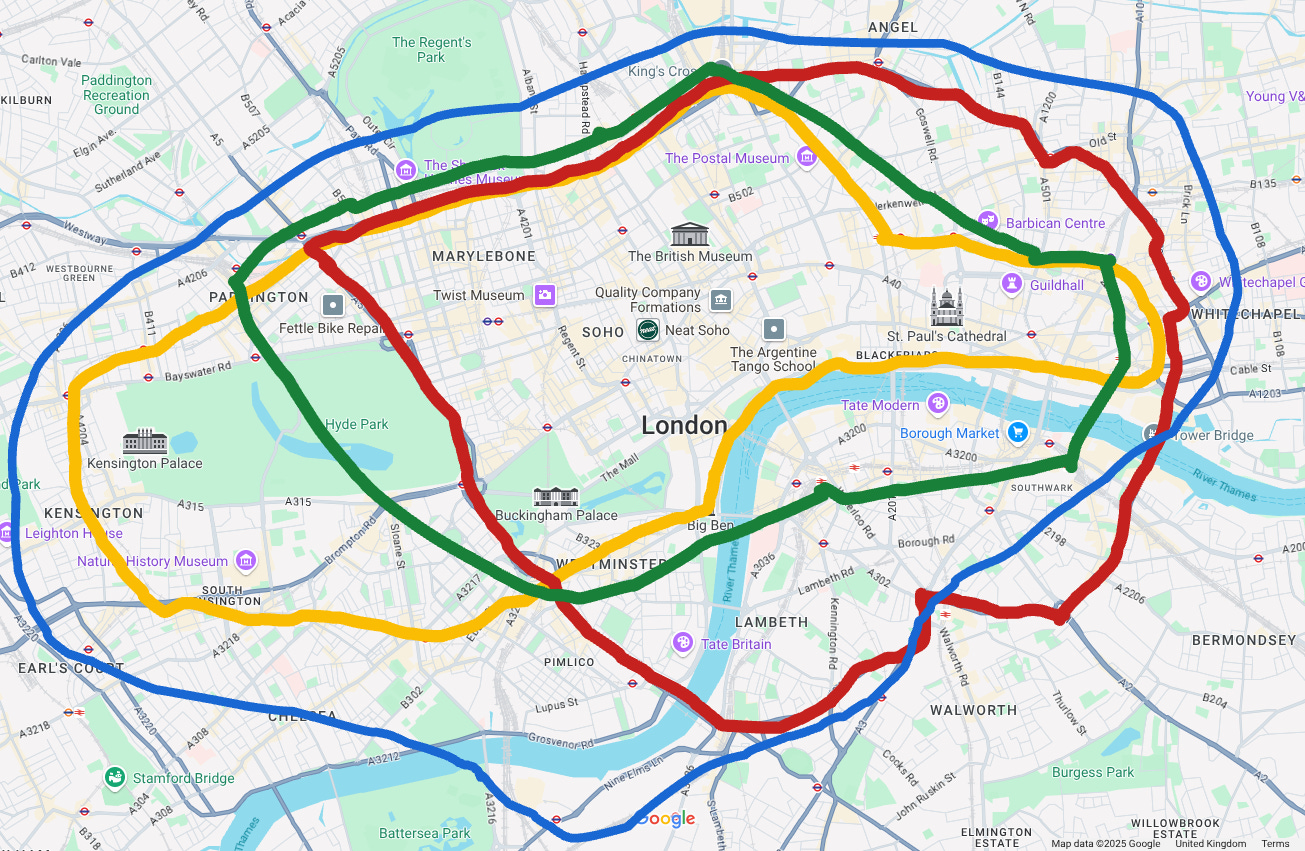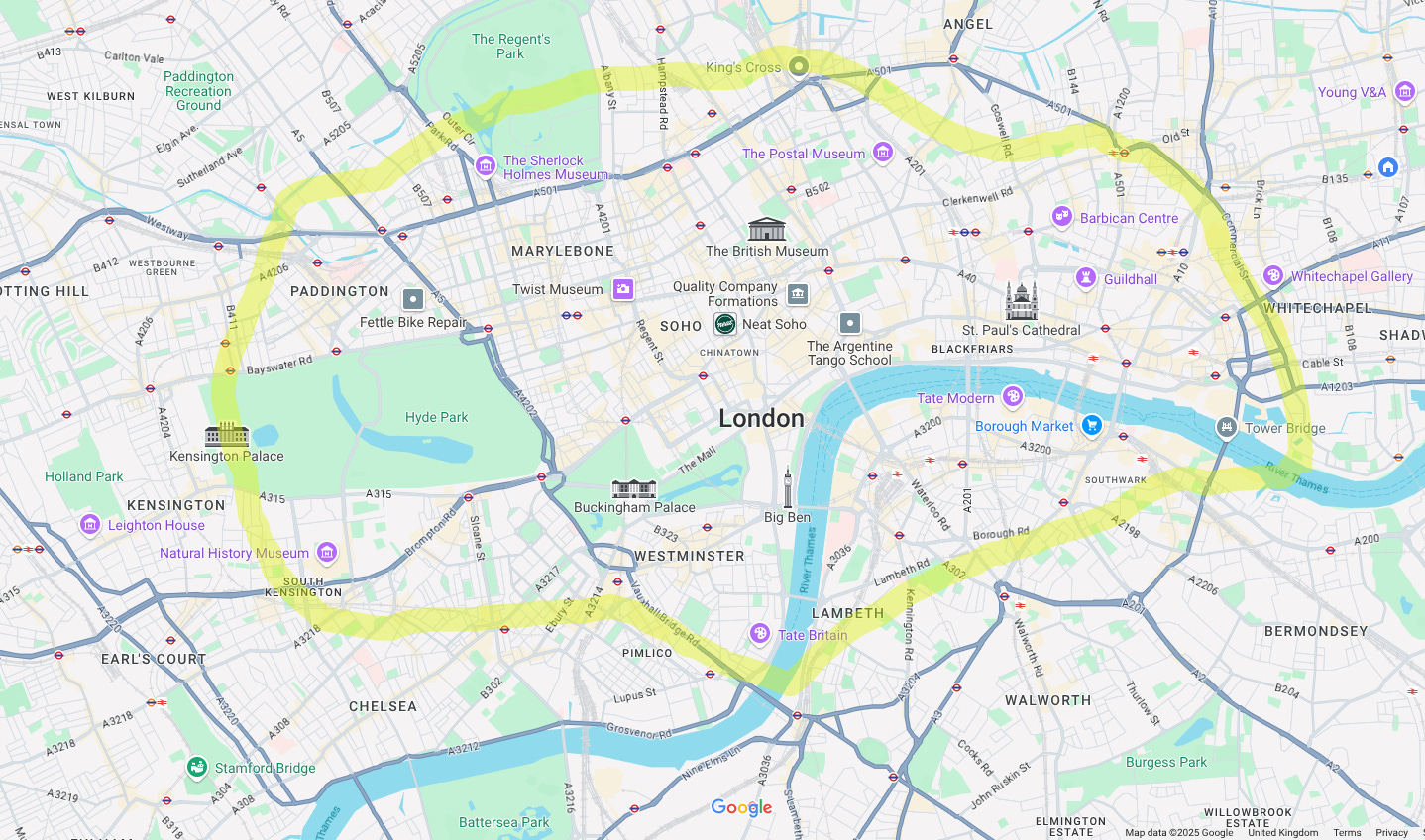This went to paying subs back in February. Worried about what you’re missing? Don’t worry, I’ve had an idea:
“A few years ago, perhaps pre-Covid, a restaurant like this in London would most likely have been found in what my kids call Central and I call the West End. (Sidebar: when did this change? How dare the young people come up with a name which makes so much more sense?)”
So runs an aside in a recent restaurant review by the food critic Jay Rayner. It’s not actually what the column is about – it’s about a bistro, in Queen’s Park – but, Londoners being who they are, most of the chat it sparked concerned the vexed question of what exactly counts as “central”. That seems to me to be more than enough of an excuse to explore the issue here, so let’s have at it.
There are, it seems to me, a number of different ways you can approach this question.
Ol’ London town
London exists because some Roman army engineers who arrived in the invasion of 43CE concluded that the site of London Bridge was the easternmost point at which they could plausibly bridge the big river that was in the legions’ way. The original London is today’s City of London, the Roman settlement built on the northern side of that bridge. That means that the original centre of London must be logically in roughly the centre of that district, just to the north of that bridge. Call it Bank Junction.
Except no one would call Bank Junction the centre of London today. That may be because, as early as the 3rd century, the city began to decline, and sometime after the Romans pulled out in the early 5th it was abandoned altogether. When the Saxons relaunched the city as a sort of trading post – we don’t know why or when; bloody Dark Ages – it was about a mile to the west of the original Roman city. The new name “Lundunwic” persists on the modern street plan as “Aldwych”: the “old wic” (basically, settlement).
No one would call Aldwych the centre of London either, although it’s surely closer. That’s because…
Centre points
...when London exploded in the modern era much of its growth was to the west of those original settlements. Partly, probably, that was because the prevailing wind blows east; and thus in London, as in many cities, those who could afford it moved west where there was less pollution and fewer smells. Partly, it may be because the centres of power were the royal palaces upriver at Westminster and Whitehall. (Those two facts are almost certainly related.)
Anyway, the official centre of London today – the point from which distances are measured and so on – is the statue of King Charles I on a traffic island at Charing Cross, a kilometre west of Aldwych, and nearly three west of the Bank.
I don’t like it – not because measuring from a memorial to a king so unpleasant we cut his head off is bad, though I’m not wild about that either, but because to me there are too many ways in which this just feels wrong. It’s possible I have an east London bias thanks to my ancestry, childhood home and current location alike, but I’m not alone: when the Post Office designed the postcode system it put this area at the very western end of WC2. Taken literally, the postcode system surely suggests that central London consists of the West Central and East Central postcodes – from Trafalgar Square to the Tower, bounded by the Thames in the south and the Euston/City roads in the north. That would logically put the city’s actual centre point somewhere on the WC2/EC4 boundary – roughly where the Temple is, very slightly east of Lundunwic.
Which I like, but suspect no one’s buying.
Some other centre points worth considering, even though I doubt anyone will buy those, either. A few years ago, my old Londonist comrade Matt Brown tried to work out the physical centre of Greater London using a cardboard cut out and some plumblines. He put it around Lambeth North tube station, which I enjoy for both the scientific method and perverse result.
Then there’s the actual Centrepoint – the building of that name, by Tottenham Court Road station. That is surely too far north to count as a plausible candidate for the central point of London – as I’ve noted before, as late as 1700 it was on the very edge of the built up area – but does sometimes feel like a plausible candidate for the centre point of its transport network, so who knows?
Some official central Londons
The truth is that London is so physically vast that central London is always going to be less of a point than a zone – one which will generally include all the possibilities I’ve already run through and more.
I say “generally” because it turns out that, between 2004 and 2008, the London Plan, the city’s official planning document, defined a Central London sub-region consisting of the boroughs of Camden, Islington, Kensington and Chelsea, Lambeth, Southwark, Wandsworth and Westminster. That list does not, you’ll note, include the City of London. For several years, Putney was included in central London; the cluster of skyscrapers in the ancient financial district were not.
This was obviously ridiculous. So when the sub-region was reintroduced in 2011 after a period of absence, it had lost Wandsworth and gained the City, which makes marginally more sense. The plan also defines the Central Activity Zone, which is this delightfully blobby thing:

That is meant to be the area that feels like the national capital – the bit with high land values, and loads of government buildings and corporate HQs, tourists and commuters. Nonetheless, the CAZ above includes the Bricklayers Arms roundabout but not South Kensington, which is surely mad. Honestly, the latter has all the big museums, wihle the former doesn’t feel like the centre of anything.
Some versions – like the one in this GLA report commissioned from consultancy Arup – even include a non-contiguous bit around Canary Wharf, but not the stretch of Wapping that would connect it to the City. That, to me, seems like cheating.1
Some central Londons of the mind
There are a number of other ways I can think of to define central London. TfL’s fare zone 1 (although that now includes Kennington and Battersea and I am not having that). The Circle line (the old one, before it stopped being a Circle, although even then I have my doubts about Notting Hill).

There’s also the boundary of the inner ring road and congestion charge zone – though again that includes the one side of the Bricklayers Arms but ejects Kings Cross, and hmmm. Then there’s the ring created by the various railway stations – which does feel fairly accurate, actually, but is kind of perverse because Victorian willingness to eject the poor but not the rich means those stations came much closer to the city on the south and east than they did in the north and west.
After all of which I am forced to conclude that what really matters is ~vibes~. As that CAZ map suggests it isn’t necessarily a clean geometric shape – there are bits outside the inner ring road that feel central, and bits inside it that do not – and it doesn’t abide by any obvious existing boundary (although the ring of railway stations comes closest). But for what it’s worth, my own take on central London is roughly as follows:
Oh, and “central London” is not quite the same as “central”. When young people refer to “central” they do seem to just mean “the West End”, not, say, the City or Shoreditch or South Ken.
But if I’d admitted that up front I wouldn’t have got a piece out of it, would I?
This newsletter is, and will always remain, needs-blind. If you want to read every week but, for whatever reason, can’t currently afford it, you can just hit reply and ask – and I’ll give you a free subscription, no questions asked. In contrast to the British state, I’d far rather accept the risk of a few people ripping me off than of those in genuine need going without.
But if you *can* afford it, I’d really like it if you
The report also divides the CAZ into three zones: the West End (sure), the City and the East (bit of a cheat, but fine) and the Riparian South (what). The word “Riparian” seems to mean “riverside” – an acknowledgement that it’s only the bit hard by the Thames that feels central-ish – but nonetheless, that’s just showing off, come on.




